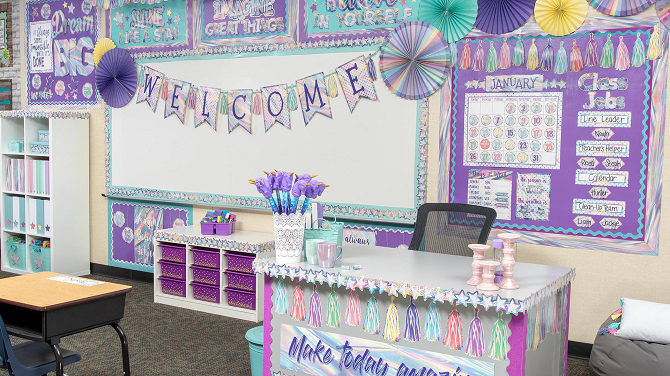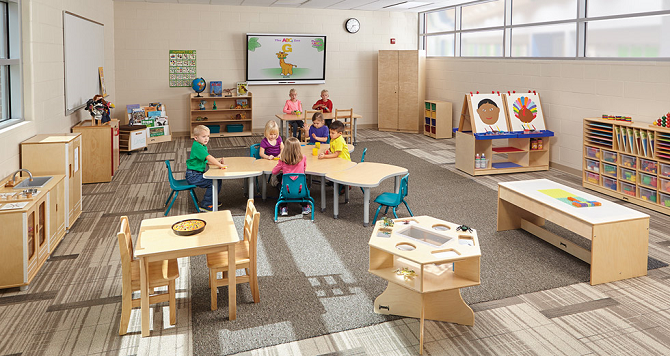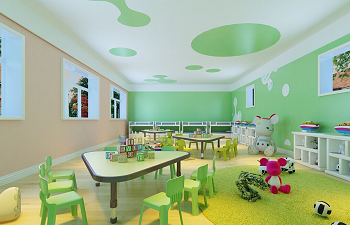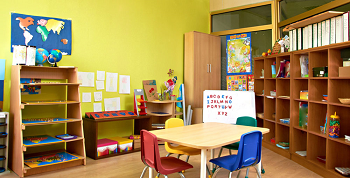Did you know the colors in your classroom environment can actually impact your student’s behavior and academic performance? Well, believe it or not, it is actually true. Being very purposeful when selecting the colors you use for your classroom walls and décor can help set your students up for success.

Now you’re probably wondering which colors you should aim to incorporate into your learning space. There isn’t just one simple answer; the colors you will want to select may vary depending on your specific students and the tone you want to set for your classroom. In the article below, we’ll help you gain a better understanding of how different colors can impact student learning and behavior. Then, you’ll be able to use this information to come up with a color scheme for your classroom that will help you achieve the results you’re looking for.
The Impact of Colors on Behavior
While more scientific studies need to be conducted, it is almost undeniable that colors can have a big impact on our behavior. For example, a study in the Netherlands compared the differences in the way poker players played and placed bets when they were given either red chips or blue and white chips. In the study, the players were more likely to be more when they were using the red chips and were more likely to fold when they were playing with the blue and white chips. This finding indicates that the different colored chips made some difference in the way the players felt and acted during the game.
This video shows some exciting facts about the impact of colors on our behavior:
More research is certainly needed to further examine the effects of color on our feelings and behavior. While some studies have been done on this topic, more controlled experiments are needed. For example, in one of the first investigations on the topic, Alexander Schauss hypothesized that pink, specifically a certain shade of pink, could produce a very calming effect in people. To test his theory, he convinced a Naval Correctional Facility to paint one holding cell that color. While the inmates in the holding cell had fewer violent incidents, the experiment wasn’t controlled. Participants weren’t randomly assigned to a pink or standard color cell. The researchers just compared the behavior of the prisoners from the previous year to the ones in the pink cell.

Clearly, studies like this have some flaws and point out the need for future research on just how colors can impact our behavior. Psychologists face the challenge of determining what the effects of colors are as well as determining how and why they affect us.
Future studies need to focus on not just comparing the effects of different hues (red, blue, green), but also on comparing the effects of the brightness or intensity of a color. For example, studies should examine the different effects of brighter blues compared to darker blues on behavior.
However, there are many signs that colors do indeed impact our behavior and feelings, so it is important to be selective when you are designing and planning out your classroom colors and décor. In the following sections, we’ll share some colors that have been shown to help boost learning in students. We’ll also share some colors that have a more negative impact on learning and behavior that you’ll want to avoid using in your classroom.
The Effects of Colors
Color psychology examines the effects of different colors on our mood. Over the years, research and experimentation have shown that different colors can indeed alter our mood, and likewise, the moods of our students.
Being aware of the ways different colors can impact your students’ mood is important. If you want to create a calming classroom environment where students with behavior problems will be less likely to act out, you’ll want to avoid colors that could lead to too much excitement. If you want to create a classroom where your students will stay alert and attentive, you’ll want to avoid colors that may have too much of a calming effect.
Use the bullet points below to identify the effects different colors can have on a student’s mood and use the information to inform how you design your learning environment.
- Red: Can help students be more alert. It also may increase creativity and excitement.
- Orange: Can help increase alertness in students.
- Yellow: May help increase attention and creativity. It also helps learners to think more positive thoughts.
- Green: Can help students feel calmer and more peaceful.
- Blue: Helps calm down students. It can also lower temperatures and suppress appetites.
- Purple: Can help students feel calmer and more peaceful.
- Brown: May help students feel safe and relaxed. It also can help keep students alert and prevent them from feeling fatigued.
- Off-White: Can help students focus on a task. It can also lead to more positive thoughts.
Now that you have a general understanding of how different colors may affect the moods of your students, you can begin to use this information to plan out your space. Think about different areas of your room and what you want students to accomplish in those areas.

For example, if you have a reflection spot/quiet spot where students are supposed to go when they need a break from the class, add accents in more calming colors, such as blue, green, or purple. For areas where you plan on delivering whole-group instruction, consider choosing yellow posters or other items that may help keep students alert and paying attention to your lesson. If you have an art area or a makerspace in your room, find ways to incorporate red to encourage creativity in your students.
Colors That Boost Active Learning
When all of your students are actively engaged and participating in the learning process, it is called active learning. As teachers, active learning is always the goal; we know our students will learn best when they are paying attention and engaged in what we are teaching. The colors you choose for your classroom can help you achieve the goal of getting all students engaged with active learning.
When planning out your room and thinking about the colors and decorations you’ll use, it is important to make sure that you don’t over-stimulate your students. If there is too much going on around them, it can be very distracting and have a negative impact on their ability to focus on instruction.

When choosing the colors for your classroom, look for options that will encourage your student to participate and help them retain the information you share. Consider choosing bright colors since they can help improve a student’s memory and stimulate their brain.
Here is a little more information about different color options that you may want to use and how you could go about incorporating them in your space:
Yellow: If you have a group of students who seems to have a tougher time paying attention, yellow is a great color to incorporate into your room. Yellow can not only help you capture your students’ attention, but it can also help you keep their attention throughout your lesson. One way you can take advantage of the effects of the color yellow is to use yellow paper for important note pages or information you share with your students. Also, consider working yellow into the overall design of your classroom by adding yellow accents, like baskets, chair cushions, or folders to your space.
Green: Green can help calm students down and can also help them concentrate on important tasks for longer periods of time. This is likely because looking at green colors does not strain our eyes and allows them to rest. Knowing how green can impact your students, you’ll also want to look for ways to incorporate it into your classroom design. Look for ways to add green near student seating areas to help them concentrate on the work they are doing at their desks. You can also add accents of green throughout your classroom to help create a calmer space for your students.

Orange: Orange can lead to an increased supply of oxygen for our students’ brains. It can also have a positive impact on their nervous systems and circulation. Because of this, when you add orange to your classroom space, it can help improve the mood of your students.
For example, more orange colors in the space may help them move on more quickly if they’re upset about something that happened at recess.
Blue: Since the color blue can calm our respiratory system and lower our heart rates, it is a good color to use in areas where your students will be engaged in tasks that require them to do a lot of deeper thinking. Try adding some blue to your students’ desks or tables to help them experience the benefits of this color. You could even tape blue strips of paper on their desks to help them stay focused and think about the work they are completing.
Red: Red can make our students feel more energized and can help them be more creative. These feelings are produced because red stimulates our adrenal glands. If you have a creativity corner in your classroom, look for ways to add red to the space to help keep students stimulated and inspire their creativity. Using red when students must complete more repetitive tasks that may cause them to get bored and zone out is also a good use for this color.
Furniture Colors
Thinking about how the colors you choose to put up on your wall and use for classroom accents is important. Likewise, it is also important to put some thought into the furniture you select for your room. Think about the amount of furniture that is in a classroom: student desks, student chairs, teacher desks, bookshelves, various tables, and so much more.
Clearly, much of what your students will be seeing in your room is furniture, so it only makes sense that you’ll want to consider the color of the furniture items in your room. Thinking about your students, the grade/class you teach, and other important factors can help you when making decisions about the furniture in your room.

If you teach younger students, for example, you may want to choose brighter colored pieces than you would if you teach high school students. Bright colors are more often associated with higher levels of energy and excitement, which may be your goal to help keep younger learners engaged in what you are teaching.
You can also use different colors of furniture to define different spaces or zones in your classroom. For example, one table/group of tables may have different colored chairs than the other tables in your space. If you have an arts and crafts area, consider using a red chair that could lead to increased levels of creativity in your students. You could consider orange chairs for the table where you instruct small groups since it could help your students remain more alert and focused on what you are teaching.

When you’re looking for new furniture for your classroom, you’ll find that there are a few different options you’ll have for adding some color. You can buy chairs that are solid colors or even add chair pockets to make them the color of your choice. You can also buy or make color bands to go around the edges of desks or tables in your room.
Other ways you could incorporate more colors into your furniture include adding colored cushions, painting table legs, or buying colored storage bins or shelves.
Colors to Avoid
In the sections above, we shared a lot of great color options you can incorporate into your classroom to help students learn and have a positive impact on their mood. However, when planning out your classroom’s color scheme, there are a few other considerations you’ll want to take into account. Some colors can have a negative impact on your students’ behavior or mood.
 In Japanese culture, some colors are associated with different emotional states. Thinking about if any of the colors you’re considering using could have a negative impact on your students’ learning can help you avoid potential issues in the future.
In Japanese culture, some colors are associated with different emotional states. Thinking about if any of the colors you’re considering using could have a negative impact on your students’ learning can help you avoid potential issues in the future.
Black is probably a color you’ll want to avoid using too much in your room. Black is often associated with death, sorrow, doom, and fear. Using too much black in your classroom could have a negative impact on your students. It may make your room too dark and gloomy and prevent them from being able to concentrate or learn. If you’re going to use black in your room, be sure to use it with other colors.
Final Thoughts
The colors you use in your classroom matter. Being purposeful with your selections can help you set your students up for success. Before planning out how you’ll decorate your room and the colors you’ll be using, think about your students, the grade you teach, and your goals and objectives for how you want your class to run. Taking the time to think about these variables can help you make color selections that will deliver the impact you’re looking for.
For example, if you are an early childhood educator, you can think about the different areas in your room and choose slightly different color schemes for each zone. If you have a reading nook, you may opt to incorporate more blues, greens, and purples in that area since these colors can have a calming effect on students.
 Yellow is a good color to use in a classroom since it can make it easier for students to focus on instruction and their assignments. Use this information to think about the areas of your room where you might want to use more yellow.
Yellow is a good color to use in a classroom since it can make it easier for students to focus on instruction and their assignments. Use this information to think about the areas of your room where you might want to use more yellow.
Perhaps, add a yellow background for the bulletin board near the table where you conduct your whole group lessons. Or, consider placing yellow borders on your students’ desks.
If you’ve noticed that your students seem to drift off during instruction for a particular subject or during the afternoons, you could try to incorporate more orange into your classroom. Orange can help increase how alert students are, which could be a way to counteract that mid-afternoon slump.
Don’t forget to also consider the colors you use on the bulletin boards outside your room and your classroom door decorations. While these are not inside your classroom, they will be one of the first things your students see before entering your room. Choosing the right colors could help put them in the right mood to get the day off to a great start.
If you’re looking for additional resources that you can use with your students once you have your classroom set up, check out these Dr. Seuss classroom ideas. Since these likely incorporate some of your students’ favorite books, they could also have a positive impact on their mood for the rest of the day.
If you are teaching online, you should also think about the colors you use in your virtual classroom. While students won’t be able to see the entire room, they’ll still be able to see the space behind your chair. When decorating this space, be sure to choose colors that will help your students stay focused and learn from your instruction. If you aren’t currently teaching online, but are interested in becoming an online ESL teacher, this article highlights some of the best online ESL platforms.
Last Updated on May 9, 2021 by Emily
- Facebook9
- Twitter21
- Pinterest67
- 97shares




